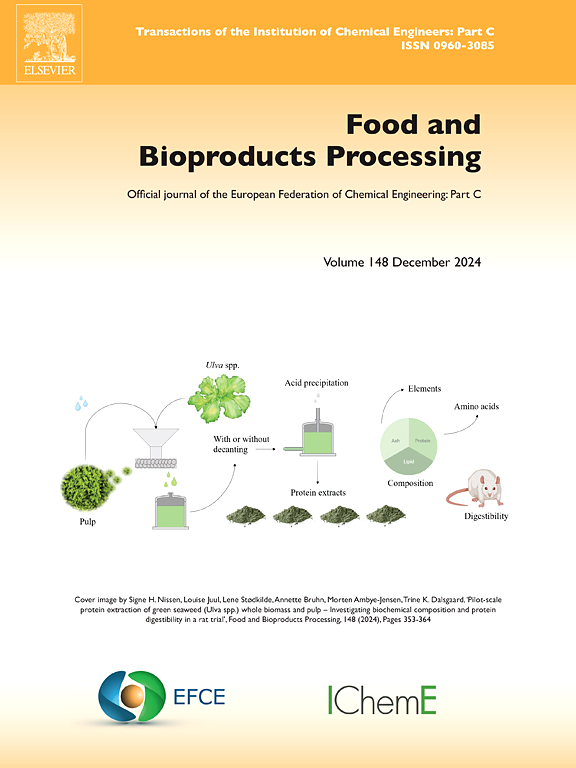Large-scale production of Nannochloropsis-derived EPA: Current status and perspectives via a biorefinery context
IF 3.5
2区 农林科学
Q2 BIOTECHNOLOGY & APPLIED MICROBIOLOGY
引用次数: 0
Abstract
The rapid rise in global population and increase in food demands have significantly propelled mass production of plant- and animal-based conventional foods, which require substantial arable lands, water, and time. Microalgae have the potential to be a sustainable and promising alternative sources of nutrient-rich food supplement, amongst which Nannochloropsis is highlighted by its high concentration of nutrient rich metabolites. Most significantly, ∼30–40% of lipids synthesized by Nannochloropsis constitute polyunsaturated fatty acids (PUFA), in which 20–30% of total fatty acids account for eicosapentaenoic acid (EPA), an essential omega-3 supplement required for human health. Nevertheless, the incorporation of whole biomass of Nannochloropsis into functional foods often imparts negative tastes and odor. Therefore, EPA could be extracted by utilizing green, sustainable methods, including microwave and ultrasound pretreatment, supercritical fluid extraction, green solvents, and purified through urea complexation. Moreover, the defatted residual biomass could be valorized to various co-products, namely biofuels, sugars, and proteins, within a zero-waste biorefinery model. Amongst the multitude of biorefinery routes available, processes starting with high value EPA extraction followed by synthesis of peptides from a protein-rich residual biomass appear to be most lucrative. Hence, the current review provides a holistic outlook on large-scale production of Nannochloropsis-derived EPA by assessing various extraction and purification methods, and functional food applications, while scrutinizing the viability of biorefining for an economically viable and sustainable commercialization.
大规模生产源自 Nannochloropsis 的 EPA:生物精炼背景下的现状与前景
全球人口的快速增长和食品需求的增加,大大推动了以植物和动物为基础的传统食品的大规模生产,而这需要大量的耕地、水和时间。微藻类有潜力成为营养丰富的可持续食物补充来源,其中 Nannochloropsis 的突出特点是富含高浓度的营养代谢物。最重要的是,拟南芥合成的脂质中∼30-40%为多不饱和脂肪酸(PUFA),其中20-30%为二十碳五烯酸(EPA),这是人类健康所需的重要欧米伽-3补充剂。然而,将 Nannochloropsis 的整个生物质添加到功能性食品中往往会产生负面的味道和气味。因此,可以利用绿色、可持续的方法提取 EPA,包括微波和超声波预处理、超临界流体萃取、绿色溶剂,并通过尿素络合纯化。此外,脱脂后的残余生物质可在零废物生物精炼厂模式下转化为各种副产品,即生物燃料、糖和蛋白质。在众多可用的生物精炼路线中,从富含蛋白质的残余生物质中提取高价值的 EPA,然后合成肽的工艺似乎最有利可图。因此,本综述通过评估各种提取和纯化方法以及功能性食品应用,同时仔细研究生物精炼在经济可行和可持续商业化方面的可行性,对大规模生产从南绿藻中提取的 EPA 进行了全面展望。
本文章由计算机程序翻译,如有差异,请以英文原文为准。
求助全文
约1分钟内获得全文
求助全文
来源期刊

Food and Bioproducts Processing
工程技术-工程:化工
CiteScore
9.70
自引率
4.30%
发文量
115
审稿时长
24 days
期刊介绍:
Official Journal of the European Federation of Chemical Engineering:
Part C
FBP aims to be the principal international journal for publication of high quality, original papers in the branches of engineering and science dedicated to the safe processing of biological products. It is the only journal to exploit the synergy between biotechnology, bioprocessing and food engineering.
Papers showing how research results can be used in engineering design, and accounts of experimental or theoretical research work bringing new perspectives to established principles, highlighting unsolved problems or indicating directions for future research, are particularly welcome. Contributions that deal with new developments in equipment or processes and that can be given quantitative expression are encouraged. The journal is especially interested in papers that extend the boundaries of food and bioproducts processing.
The journal has a strong emphasis on the interface between engineering and food or bioproducts. Papers that are not likely to be published are those:
• Primarily concerned with food formulation
• That use experimental design techniques to obtain response surfaces but gain little insight from them
• That are empirical and ignore established mechanistic models, e.g., empirical drying curves
• That are primarily concerned about sensory evaluation and colour
• Concern the extraction, encapsulation and/or antioxidant activity of a specific biological material without providing insight that could be applied to a similar but different material,
• Containing only chemical analyses of biological materials.
 求助内容:
求助内容: 应助结果提醒方式:
应助结果提醒方式:


